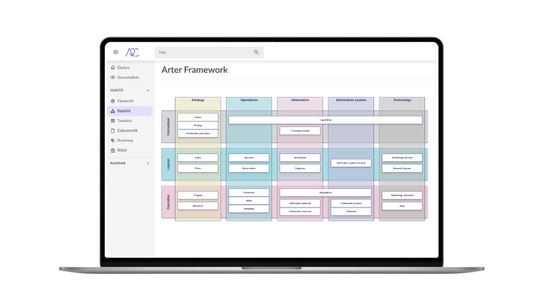

How to start documenting processes?
Kirjoittaja:
Start documenting processes from a process chart and process tree – A process chart is an operational extension of the strategy and illustrates the organization’s operational logic
- The organization’s management defines the process chart and process tree.
- The process chart presents the core and support processes identified by the organization’s management – it defines the processes to be described and their relationship to each other.
- However, not all processes need to be described; essential aspects can also be instructed traditionally.
When creating a process chart, you can start with the business’s central processes and those critical to customers, for example:
- Identify core and support processes first, then build the process chart.
- Build the process tree from the subprocesses of core and support processes.
- Start by drawing process flowcharts for the lowest-level processes.
Don’t settle for mere process descriptions – enrich process descriptions as follows
✅ Extensive use of the 3-page technique – combine more detailed instructions and a summary page with the process description.
✅ Linking work instructions and template documents to process descriptions.
✅ Identifying process risks.
✅ Collecting data through reporting, and
✅ developing process metrics.
Before you start describing processes, go through these things
Before describing processes, it’s important to clarify the purpose of description and consider getting the basics of process description in order.
It’s also important to determine:
✅ What expertise exists in the organization for process description.
✅ The purpose of process work.
✅ Existing descriptions and instructions for description and
✅ the scope and schedule for describing processes.
Describe processes as high-level as possible but as accurately as needed
- One of the biggest pitfalls in describing processes is to describe them in too much detail. Detailed description is so laborious that describing processes may become one-off, and the maintenance of descriptions may not continue.
- A simple rule when describing processes is: describe as high-level as possible but as accurately as needed. Always consider who the description is for and what their needs are regarding the description.
- It’s often easier to start by describing a few processes and then move on to describe the organization’s processes more broadly than to start describing all processes at once.
Involve people in creating process flowcharts
It’s important to involve people in the processes fairly early. However, the purpose of process descriptions is to describe actual work. If only one person describes the process, it’s often just a narrow view of the operation.
A process flowchart that is described and gone through together is more likely to be actively used.
Deployment of process flowcharts
- When adopting and describing process flowcharts it’s important that processes are easy and flexible to modify and easily accessible to everyone.
- The more people in the organization start describing processes, the more resources are needed for their training, so the software used for describing processes should be quick to learn.
Keys to successful process work – remember at least these 5 points
- Clarify the goal and purpose of process work – There should always be clear goals when starting and doing process work.
- Involve and train.
- Start describing the process simply, and refine as needed.
- Take responsibility, support, and ensure the deployment of process work – Bringing processes into the organization is often a long road, so it’s important to see if the set goals have been achieved.
- Highlight results – It’s important to clearly display successes. When successes are made visible, the integration of processes into the organization’s continuous improvement is more likely.
Lue lisää
-
 Published on:
Published on: -
 Published on:
Published on:What is quality management with IMS software?
-
